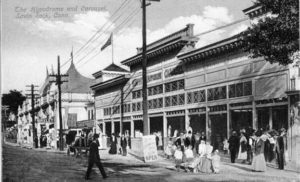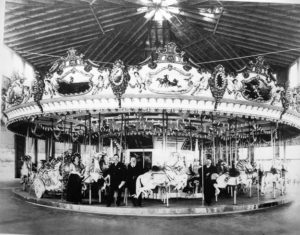
When The Flying Horses Came To West Haven – Part Two
West Haven’s George Cameron was already a wealthy businessman by the time he met the Murphy brothers when they took rooms at Cameron’s Seaview Hotel in 1906. As mentioned in last week’s installment, the Murphys had big dreams for Savin Rock and Cameron embraced those ideas with open arms and an even bigger checkbook. If all went as planned, they stood to make a fortune in an era when amusement parks drew millions of visitors annually. Then, too, the Murphy brothers seemed to be the real thing. They had impeccable credentials as carousel builders, having worked for the famous Coney Island carousel maker Charles Looff since they were teenagers. They also operated at least three other carousels by the time they arrived in West Haven. If Cameron needed any more persuading, the Murphys had a carousel already to go for their Savin Rock Hippodrome – a combination nickelodeon, heated saltwater swimming pool, carousel, and carousel manufacturing facility all under one roof.

Installed around 1906, the merry-go-round was a Looff carousel with beautiful stationary figures, called standers. According to carousel historian Barbara Williams, the carousel (the building is shown above) was similar to what the Murphy brothers built in Providence in 1896.
But the Murphys now offered a game changer at Savin Rock carousels — introduced by Timothy Murphy in 1907. They were called jumpers — or horses that went up and down. After Murphy introduced jumpers to Savin Rock, it changed everything. Every other Savin Rock carousel owner was forced to upgrade his carousels to jumpers if he wanted to remain competitive. And in many respects, it also forced Cameron’s major competitor, Fred Wilcox, to eventually order the famous PTC No. 21.
The Murphys first used the up-and-down mechanism on a composite merry-go-round – meaning it contained figures from a number of famous carvers, from Charles Looff and Stein & Goldstein to Charles Carmel. This carousel ran at Savin Rock until 1911 – when the brothers sold it to Lake Compounce, where it remains today as a registered National Historic Landmark. Its creation set a pattern for the Murphys that seemed a fool-proof way to make money. Why?
First – many of the carvers were personal friends and associates of the Murphys. Just as important — they had a great eye as scavengers or what The History Channel today might call “American Pickers.” In fact, the Murphys made a business out of buying up carousels that had fallen victim to financial woes or their age-old nemesis – fire. There were so many amusement park fires, in fact, that Coney Island actually mounted an immensely popular stunt spectacular in 1904 called “Fighting the Flames,” which ended up being one of history’s first movie shorts. That little movie, in fact, was likely showing in Murphy’s Nickelet when Timothy and Bart opened up the spectacular Murphy’s Hippodrome in 1907 on Beach Street right across from the Sea View Hotel on land that George Cameron owned.
Underwritten by Cameron, the Hippodrome featured a beautiful 3-row carousel, shown here with all jumpers. Some people think that is Timothy Murphy at the far right and Bart Murphy is in suit and tie.
What is certain is that Savin Rock had not seen the likes of the Hippodrome before. In addition to the Nicolet, two carousels and a restaurant, there was even an outdoor, heated, saltwater swimming pool extending over Long Island Sound. As my Irish grandmother might have said, only an Irishman could get away with that one.
To be continued…
Guest Historian: Peter J. Malia, Author of Visible Saints: The Colonial History of West Haven, available from Barnes & Noble and www.connecicutpress.com